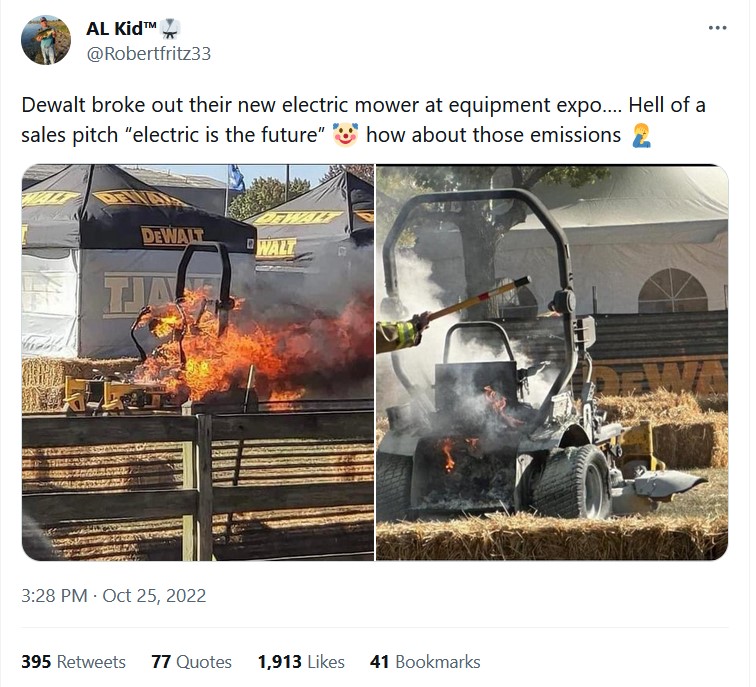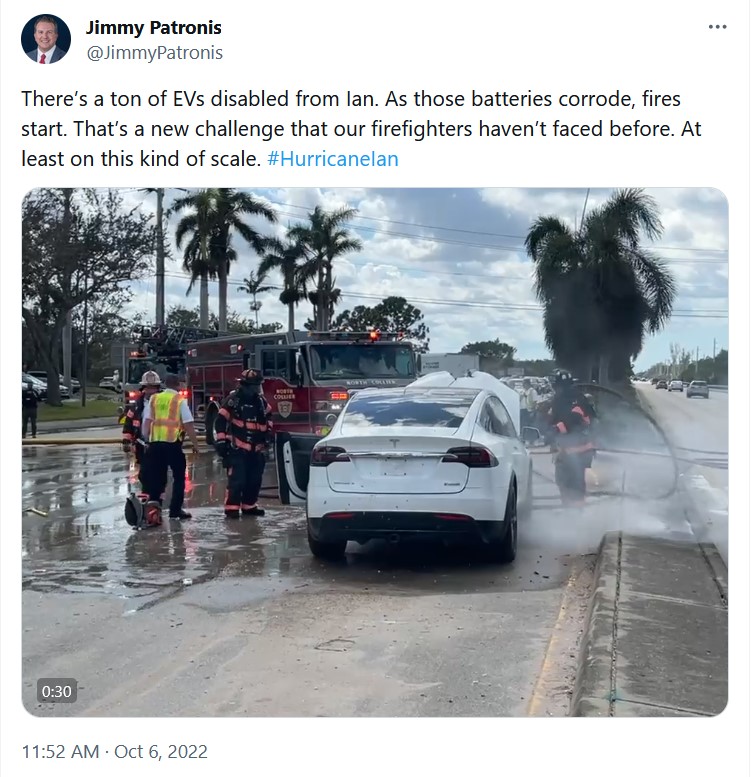In yet another example of an EV not doing quite what it’s supposed to when debuted, the DeWalt electric mower scheduled to be released in 2023 burst into flames and turned into a roaring, blazing inferno at the Equip Exposition Outdoor Demo Yard.
That exposition’s Facebook account posted about the incident, saying: “Today, in the Equip Exposition Outdoor Demo Yard, a mower caught on fire. There were no injuries. The unit has been removed and the Demo Yard will re-open in the morning, October 20, at 9 a.m. as scheduled.” And here is a tweet with some images of the roaring blaze and the smoldering mower:

The context for the video, as provided by Snopes, is that: “The electric mower that appeared in videos was a “single pre-production prototype unit,” according to a company statement. The Lawn & Landscape blog reported that the prototype was part of DeWalt’s battery-powered Ascent Series, which wasn’t expected to be made available to the public until fall 2023.
DeWalt, replying to both Snopes and the Lawn & Landscape blog when asked about the inferno incident with the electric mower, said: “We are grateful that no one was injured. We are working quickly to determine the cause of the issue with this single pre-production prototype unit and will provide further information when available.”
Combustion-powered vehicles can catch on fire too, of course. Gas and diesel are, well, combustible. The problem with most electric, battery-powered vehicles, whether a mower or a top-of-the-line Tesla, is the lithium battery, if it does ignite, is near impossible to put out because of the heat at which lithium-ion batteries burn if ignited.
That became a problem in Florida following Hurricane Ian. Some of the EVs caught in Hurricane Ian’s path were flooded and, as a result, their batteries corroded. Those batteries then ignited, turning the Teslas into torches and became yet another problem Florida firefighters had to deal with in the hurricane’s aftermath.

And the problem isn’t confined to Tesla and DeWalt. It happened to a man’s EV Jaguar as well, almost causing a catastrophic house fire. Speaking about that fire, the Jaguar owner said: “On June 16, I plugged the car in before going to bed. In the morning of June 17, I woke up and unplugged the car. Later that morning, I set out to run some errands. I drove about 12 miles that morning before returning back home and parking the car back in the garage, leaving the garage door open.”
He continued, ” As I was doing things at home, I heard pops coming from the garage. I decided to go see where the sounds were coming from, and upon walking into the garage, I faced a thick wall of smoke. My thought immediately was, ‘When there is smoke there is fire,’ and I need to get the car out of the house garage. I went back to the house to get my phone and also noticed that all the smoke in the garage now had filled my entire house because the A/C unit is right next to the garage door. While I was trying to ventilate my house from the smoke I called Jaguar roadside assistance to have them come get the car.”
He then said, “When I ended the conversation with them there were more pops, but this time it was followed by fire from under the car. I then called 911 to come help with the situation. But this was not a slow burn, once the fire started there were multiple pops, and the car was just engulfed in flames rapidly.”
WATCH the video of the electric lawnmower catching fire:
"*" indicates required fields
